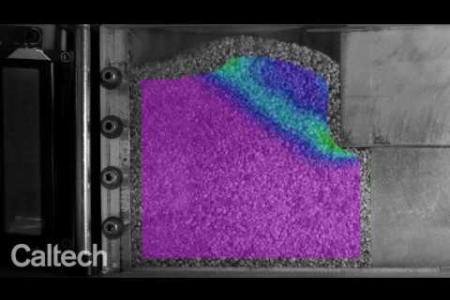Andrade - Shear Earth

Civil engineers have developed a new method that measures the way forces move through granular materials—one that could improve our understanding of everything from how soils bear the weight of buildings to what stresses are at work deep below the surface of the earth.
Granular materials—conglomerations of solid particles larger than a micrometer, such as gravel or coffee grounds—are everywhere in the world around us. The snow on a mountain top is a granular material, as is the grain stored in a silo. Granular materials exhibit distinct and sometimes unusual properties. For example, if you shake an aggregate composed of particles spanning a wide range of sizes, the larger particles rise to the top; this counterintuitive behavior is known as granular size separation, although it is sometimes referred to as the "Brazil nut effect" because large Brazil nuts tend to rise to the top of a packet of mixed nuts.
Because of their ubiquity, granular materials are of significant interest to scientists and engineers. And an important goal of granular material science is to be able to measure how forces move through such materials, says Caltech's Jose Andrade, professor of civil and mechanical engineering in the Division of Engineering and Applied Sciences. "It is the ultimate frontier in granular materials," he says. "Understanding the way they move and carry forces will help us reconstruct their collective behavior."
Andrade and his colleagues used a combination of computed tomography (CT) scanning and X-ray diffraction to measure the deformation of individual grains, in effect turning each particle into a force gauge that shows the direction and intensity of force.
Imagine two identical houses: one sitting on bedrock and the other on a sandy soil. Both are subject to gravity's downward pull. The mass of the house on bedrock, because it pushes on a solid object, generates a force that is easy to model. However, the force generated by the house on sand, although identical, is much more difficult to model because it is dispersed across many millions of sand grains, each with a different shape and orientation and moving with respect to one another and in different directions.
In this example, the house on sand exerts force on the grains that it touches, which exert force on the grains around them, which in turn exert force on the grains below them, and so on. The force is not transmitted straight down, but rather radiates out in asymmetric patterns determined by each grain's shape and interaction with its immediate neighbors.
Prior research measuring forces in granular materials often used grains made of a special material that shines when placed under stress. By observing which grains were shining and which were not, researchers could track the propagation of stress through the material as a whole. Andrade and his colleagues, however, wanted to be able to track the propagation of stress through any granular material. Their new technique is based on the fact that, when under stress, the shape of an individual grain will change slightly, much the way a foam ball deforms to varying degrees based on how hard you squeeze it.
The team used CT scanning to reveal how particles are shaped and oriented and X-ray diffraction to show—at an atomic level—how those particles deform under pressure. This information was then used to calculate how much force each individual grain is under and to quantify the transmission of force through granular materials.
More than just a proof-of-concept, the test revealed a surprising characteristic of granular materials: the more external pressure is placed on them, the more homogenous the substance acts, regardless of how heterogenous the grains may actually be. As the team slowly increased the amount of force on their test particles, they noted that the dispersion of that force grew more equitable throughout the entire material.
The observation led to an unforeseen connection with the social sciences.
Social scientists use a statistical expression called the Gini coefficient to measure income and wealth inequality in societies. For example, a Gini coefficient of 0 signifies a society in which all of the wealth is concentrated in the hands of a single individual, while a coefficient of 1 signifies a society in which everyone has an equal share.
Andrade and his colleagues found that this same coefficient can be used to model the dispersion of force through granular materials. "To draw a correlation, the granular 'societies' in our samples become more equitable as external pressure increases," Andrade says. "We can call this observation granular solidarity."
Being able to quantify granular solidarity means that engineers will know how much external pressure a granular material needs to be under before it behaves like a single, unbroken material—as opposed than a collection of tiny grains. The finding could simplify future engineering calculations about granular materials.
The work is described in a paper, titled "Quantifying Interparticle Forces and Heterogeneity in 3D Granular Materials," published online on July 18 in the journal Physical Review Letters. Coauthors on the paper include Ryan Hurley, formerly of Caltech but now with the Lawrence Livermore National Laboratory; S. A. Hall of Lund University in Sweden; and J. Wright of the European Synchrotron Radiation Facility in France. The research was funded by the U.S. Air Force Office of Scientific Research, the U.S. Defense Threat Reduction Agency, Lawrence Livermore National Laboratory, and the European Commission.
No comments:
Post a Comment
Note: Only a member of this blog may post a comment.